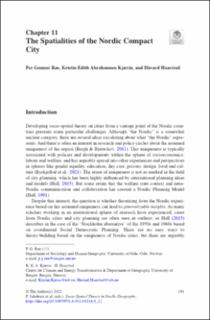| dc.contributor.author | Røe, Per Gunnar | |
| dc.contributor.author | Kjærås, Kristin Edith Abrahamsen | |
| dc.contributor.author | Haarstad, Håvard | |
| dc.date.accessioned | 2023-02-16T08:05:27Z | |
| dc.date.available | 2023-02-16T08:05:27Z | |
| dc.date.created | 2022-11-08T13:55:25Z | |
| dc.date.issued | 2022 | |
| dc.identifier.isbn | 9783031042331 | |
| dc.identifier.uri | https://hdl.handle.net/11250/3051300 | |
| dc.description.abstract | The compact city has become the preferred and mainstream model for urban, peri-urban and sometimes even rural planning in the Nordic context. However, the compact city is increasingly contested as a model for sustainability and may be criticized for a functionalistic perspective on social practices and transitions. Besides, the compact city model is part of increasing transnational or global urban policy mobilities including generic models and strategies, and it may be argued that this contributes to the de-contextualisation of urban planning and development. In this chapter we scrutinize the spatialities of the compact city model and examine how the compact city model has played out in the Nordic context – focusing in particular on Oslo. We ask: how is the compact city developed and promoted as a spatial model? We argue that although the compact city has to some extent been promoted in influential policy circles as a universal model, the compact city in Oslo has some distinct features shaped by the Nordic context. In particular, these features can be attributed to welfare state governance centred on the public sector, yet it is also here we find some of the most significant differences between the Nordic countries. In closing, we discuss whether there is such a thing as a Nordic compact city model, and point to some of its political, social and cultural implications. Is there a pathway for a re-contextualized, relational and grounded compact city model? | en_US |
| dc.language.iso | eng | en_US |
| dc.publisher | Springer | en_US |
| dc.relation.ispartof | Socio-spatial theory in Nordic geography : Intellectual histories and critical interventions | |
| dc.rights | Navngivelse 4.0 Internasjonal | * |
| dc.rights.uri | http://creativecommons.org/licenses/by/4.0/deed.no | * |
| dc.subject | Byplanlegging | en_US |
| dc.subject | Urban planning | en_US |
| dc.subject | Bærekraftig byutvikling | en_US |
| dc.subject | Sustainable urban development | en_US |
| dc.subject | Byutvikling | en_US |
| dc.subject | Town development | en_US |
| dc.subject | Fortetting | en_US |
| dc.subject | Urban compaction | en_US |
| dc.title | The Spatialities of the Nordic Compact City | en_US |
| dc.type | Chapter | en_US |
| dc.description.version | publishedVersion | en_US |
| dc.rights.holder | Copyright 2022 the authors | en_US |
| cristin.ispublished | true | |
| cristin.fulltext | original | |
| cristin.qualitycode | 1 | |
| dc.identifier.doi | 10.1007/978-3-031-04234-8_11 | |
| dc.identifier.cristin | 2070636 | |
| dc.source.pagenumber | 191–205 | en_US |
| dc.relation.project | Norges forskningsråd: 255189 | en_US |
| dc.relation.project | Norges forskningsråd: 295704 | en_US |
| dc.subject.nsi | VDP::Samfunnsgeografi: 290 | en_US |
| dc.subject.nsi | VDP::Human geography: 290 | en_US |
| dc.identifier.citation | In: Jakobsen, P., Jönsson, E., Larsen, H.G. (eds), Socio-Spatial Theory in Nordic Geography, 191–205. | en_US |

